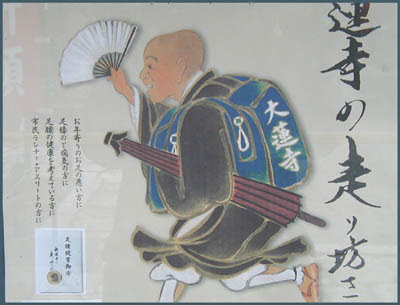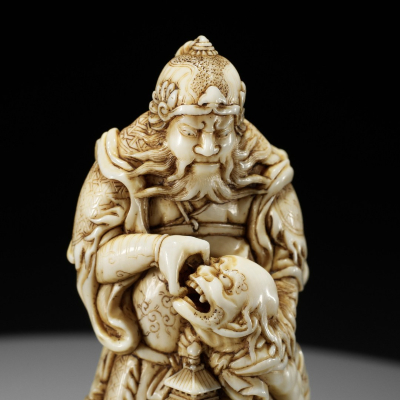:::::::::::::::::::::::::::::::::::::::::::::::::::::::::::::::::::::::::::::::::::::::::::::::::::::
Fudo Myo-O Gallery
:::::::::::::::::::::::::::::::::::::::::::::::::::::::::::::::::::::::::::::::::::::::::::::::::::::
Idaten (Skanda)
韋駄天
English introduction see
Mark Schumacher
The Indian deity Skanda, son of Siva (Shiva) and general of his army, who became a protector of the Dharma in Buddhism. The names Sukanda 塞建駄, Shikenda 私建陀, Kenda 建陀, and Ida Shougun 韋駄将軍 (General Ida) are also used.
. Tenbu ... Celestial Beings, Deva
Idaten
:::::::::::::::::::::::::::::::::::::::::::::::::::::::::::::::::::::::::::::::::::::::::::::::::::::
In Chinese and Japanese mythology,
Ida-Ten is the God of law, truth, purity, legal victory and justice. He is a protector of monasteries and has miraculous speed. Ida-Ten is a popular protector of the faith and the general-in-chief under the lokapalas, the regents of the four quarters. A protector of Monks, he is generally represented both in China and in Japan as a young man dressed in the attire of a Chinese general, either leaning on his weapon, which rests on the ground, or with a sword lying across his folded arms. A guardian king of the south, his images have been set up facing the main sanctuary of a temple. He is supposed to have a violent temper, which portrays him to be a warrior deity.
After the Buddha had entered Nirvana, a swift-footed demon stole one of the teeth of the cadaver and escaped at great speed. Ida-Ten witnessed this, and pursued immediately, bounding over mountains and across rivers, until he finally trapped the thief and retrieved the relic. The Japanese expression Ida-ten hashiri (to run like the wind) derives from this story.
In some Zen sects, he is the titular deity of the meal. He is mentioned in the pre-meal prayers at Sōtō Zen temples. He presides over the meals as protector of nourishment, but also as a warning to control the appetites.
© More in the WIKIPEDIA !
Galerie Zacke, facebook
Idaten dressed in full Tang Chinese armor, carrying a sheathed sword on his back, capturing the oni Shoshitsuki who has stolen a Buddhist reliquary containing one of Buddha’s teeth.
:::::::::::::::::::::::::::::::::::::::::::::::::::::::::::::::::::::::::::::::::::::::::::::::::::::

. Bunraku puppet play performance 文楽

:::::::::::::::::::::::::::::::::::::::::::::::::::::::::::::::::::::::::::::::::::::::::::::::::::::
火に克ちて毛虫韋駄天ばしりかな
hi ni kachite kemushi Idaten-bashiri kana
trying to win against the fire
the hairy caterpiller runs
like Idaten
Awano Seiho 阿波野青畝 (1899 -1992)
.................................................................................

Statue at Yokohama, Yamashita Park
韋駄天の新聞少年露まとふ
Idaten no shinbun shoonen tsuyu matou
the newspaper boy
runs like Idaten
clad in dew
Yata san 矢田鹿苑子
:::::::::::::::::::::::::::::::::::::::::::::::::::::::::::::::::::::::::::::::::::::::::::::::::::::
:::::::::::::::::::::::::::::::::::::::::::::::::::::::::::::::::::::::::::::::::::::::::::::::::::::
Idaten (Skanda)
韋駄天

Auch "General Ida" (Ida Shoogun) genannt. Indische Gottheit, Kind des Shiva und der Paarvati. Bruder ist Kankiten (Ganesh). Einer der acht Generale eines der vier Himmelskönige, des Zoochooten. Lebt zurückgezogen von der Welt, führt ein Leben der Reinheit und schützt die Lehre. Auch als Schützer vor Kinderkrankheiten verehrt.
Als bei der Feuerbestattung des Shakyamuni ein böser Dämon einen Zahn stehlen wollte, verfolgte Idaten blitzschnell den Räuber und stellte ihn. Noch heute werden daher in Japan Leute, die beson~ders schnell laufen können, "Idaten" genannt. Eine schnelle Art, die Puppen im Bunraku-Theater zu bewegen, wird ebenfalls "Idaten-Laufen" genannt.
Schutzgottheit der Mönche und ihrer Unterkünfte. Wenn man zu dieser Gottheit betet, hat man immer genügend zu essen.
Besonders in der Zen-Sekte verehrt, weil er müde Mönche bei der Meditation anspornt.
Ikonografie:
Trägt chinesische Rüstung, fast immer mit Helm. Trägt einen Donnerkeil oder ein liegendes Schwert vor der Brust auf den gefalteten Händen. Diese Gegenstände waren immer aus einem anderen Material als die Hauptstatue, so daß sie heute fast alle verloren sind.
Er steht auf fliegenden Wolken, die seinen schnellen Lauf ausdrücken sollen.
:::::::::::::::::::::::::::::::::::::::::::::::::::::::::::::::::::::::::::::::::::::::::::::::::::::
.Buddhastatuen ... Who is Who
Ten 天 (Devas)
.Buddhastatuen ... Who is Who
Ein Wegweiser zur Ikonografie
von japanischen Buddhastatuen
Gabi Greve, 1994
:::::::::::::::::::::::::::::::::::::::::::::::::::::::::::::::::::::::::::::::::::::::::::::::::::::
Daruma Pilgrims in Japan
O-Fudo Sama Gallery
:::::::::::::::::::::::::::::::::::::::::::::::::::::::::::::::::::::::::::::::::::::::::::::::::::::







No comments:
Post a Comment